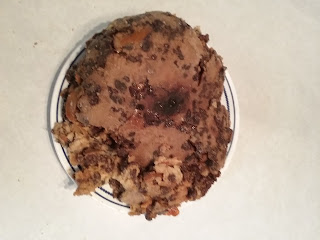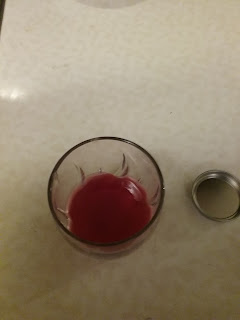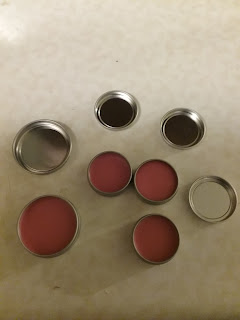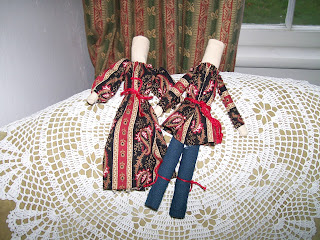Another tardy post, I fear. The pudding was originally made within the challenge fortnight (December 13), but scheduling complications delayed it's debut by a week, and I've procrastinated writing this post since then.
The Challenge: "Foreign" Foods Make a dish that reflects the historical idea of “foreign” - either foods with a loose connection to foreign lands, named after faraway places, or attributed to foreigners. Real connections to actual foreign countries not necessary (or recommended) - the more tenuous the connection, the better.
Making a Christmas pudding is definitely a British practice, and thus foreign to this American. After all, it's not like I use Mrs. Beeton's for most of my other challenges anyway.
1328. INGREDIENTS – 1–1/2 lb. of raisins, 1/2 lb. of currants, 1/2 lb. of mixed peel, 3/4 lb. of bread crumbs, 3/4 lb. of suet, 8 eggs, 1 wineglassful of brandy.
Stone and cut the raisins in halves, but do not chop them; wash, pick, and dry the currants, and mince the suet finely; cut the candied peel into thin slices, and grate down the bread into fine crumbs. When all these dry ingredients are prepared, mix them well together; then moisten the mixture with the eggs, which should be well beaten, and the brandy; stir well, that everything may be very thoroughly blended, and press the pudding into a buttered mould; tie it down tightly with a floured cloth, and boil for 5 or 6 hours. It may be boiled in a cloth without a mould, and will require the same time allowed for cooking. As Christmas puddings are usually made a few days before they are required for table, when the pudding is taken out of the pot, hang it up immediately, and put a plate or saucer underneath to catch the water that may drain from it. The day it is to be eaten, plunge it into boiling water, and keep it boiling for at least 2 hours; then turn it out of the mould, and serve with brandy-sauce. On Christmas-day a sprig of holly is usually placed in the middle of the pudding, and about a wineglassful of brandy poured round it, which, at the moment of serving, is lighted, and the pudding thus brought to table encircled in flame.
The Date/Year and Region: 1861, London
How Did You Make It: I grated all the stale bread in my stash, until 12 oz. were obtained. I then chopped up all the candied peel I had on hand (mostly orange with some lemon), which came in just under 8 oz. I mixed these up with 24 oz of raisins, 8 oz of zante currants (actually a raisin variety, but the closest I could find to actual currants in my area), 0.78 lb rendered pork fat (lard, as five trips to butcher shops and meat counters could not procure suet), 8 eggs, and 1.5 oz of brandy (= 1 wineglass, says this 1842 book).
After mixing this thoroughly, I piled it all up on a clean square of cotton, and tied it into a round bundle. I then attempted to rig up a system to hold the pudding suspended in a large stock pot of boiling water for six hours--said device included part of a bookshelf, string, and a dumbbell; it also proved ineffective as 1) the pudding appeared to be floating anyway, and 2) it somehow still got scorched on the bottom. C'est la vie.
I then let the pudding drip dry for three days. Boiled it a further two hours before intending to serve it, but the pudding had gone completely soft and mushy by that point, so I ended up hanging it up again for three more days. I then attempted to serve it cold, but unwrapping the pudding caused it to fall apart.
Time to Complete: An eternity. Preparation took about an hour and a half, including grating crumbs; boiling took six hours, drying took several days, and the final boiling should have taken two hours.
Total Cost: Ingredients on hand, except for the fresh lard, which was about $6 at the fancy butcher shop (which totally said they would have suet after the weekend, and then didn't. Grah.) It was actually a good receipt for the moment, in that it allowed me to use up some of my weird ingredients before moving--ie the bread crumbs, candied orange peel and raisins that were filling my fridge.
How Successful Was It? Not at all. This is the worst cooking experiment since the
Cherry Pie of '14, and honestly might be the worst of all. Though initially solid, the re-boiling attempt softened it up a great deal, and no amount of drying thereafter restored its structural integrity. I also managed to burn the top of the pudding where it came in contact with the bottom of the pot (my rigging apparently was less successful than I thought it was). I couldn't serve it properly with flaming brandy, on account of the aforementioned instability, as well as the fact that it was too large to fit easily on a plate.
In its favor, the pudding was nice and moist, the bread crumbs incorporated well, and the raisins and peel tasted nice. That being said, there was no other sweetener, and the main flavor was raisin and brandy.
If I try this again, I will: 1) half the recipe, 2) use real suet, 3) let the pudding dry for weeks or months instead of days, 4) properly suspend the pudding while boiling, and 5) ideally use a mold rather than attempting to tie the pudding up in a cloth. I'm also likely to try another recipe, as this was a great deal of work for not even a qualified successul.
How Accurate Is It? Hard to say. The main liberty was substituting lard for suet, but that's still a period ingredient, so... fairly accurate?
 |
What it should look like.
(Color plate from a later edition of the BoHM) |
 |
| Plum pudding: not a success. |










